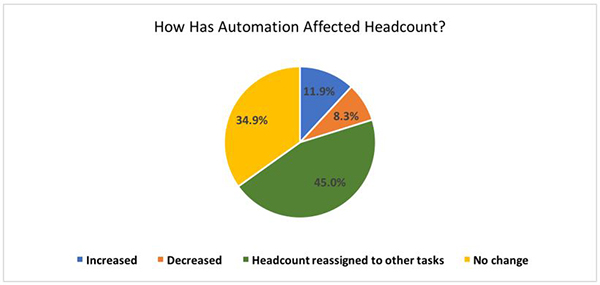Date Published September 6, 2017 - Last Updated April 19, 2019
As usual, there is a major gap between what the headlines say and what we are experiencing in our daily work lives. If we were to take all the articles predicting “the end of work” at face value, we’d probably all be gathering food and water and building bunkers. It isn’t really like that. So instead of guessing at the future, let’s look at the present to get some sense of what is going on.

Source: HDI (2017)
To date, automation has led to a decrease in headcount in just over 8 percent of organizations, while there has been an increase in headcount in about 12 percent. In 45 percent of organizations in our study, people have been “reassigned to other tasks.” In some ways, this reassignment has been going on for years.
Learn more about the state of automation in the HDI webinar Automation and AI in the Workplace: Are Bots the Future?
Take password resets for example. The old model (still happening in many organizations) was that people would call in or visit the support center, and their passwords would be manually reset. Password resets were, industry-wide, about 30 percent of total contact volume. When automated password and identity management systems gained traction, the work shifted.
In many cases, the contact volume for password resets went up after automated systems were installed, but those days are—mostly—behind us as people have grown much more familiar with the whole process. Security questions and password requirements are commonplace in daily life, and people have learned how to deal with them. Improvements have also been made on the IT side of the equation, where the need for users to remember multiple passwords has been reduced.
The bottom line here is that 30 percent of the support workforce didn’t disappear as the result of automated password reset; instead, they moved on to more complex tasks. Year after year, case volume goes up in support, with the number of customers, applications, and devices cited among the reasons.
Work hasn’t gone away; its complexity has increased.
Way back when help desks were just getting started (and dinosaurs roamed the earth), the model for Level 1 support was catch and dispatch: Take the call, write down the description, and forward the case to someone else to be worked on. Now, we try to resolve as many incidents and requests as possible on first contact using sophisticated service management tools, knowledge bases, remote control, and monitoring. The level of technical proficiency at Level 1 has increased, and the more complex demands have been met.
The level of technical proficiency at Level 1 has increased.

The question, then, is not whether work will still exist, but what will the work look like? What skills will be necessary as advanced technologies such as machine learning and AI take their places in the businesses we support?
Some of the skills future analysts will need include:
- Knowledge capture and sharing
- Complex problem solving and troubleshooting
- Database queries and data visualization
- Process and procedure development and documentation
- Network configuration and troubleshooting
- Collaboration in person and via electronic methods
- Understanding multiple frameworks and methodologies
- Business relationship management
The need for good communication and customer service skills will not go away, but added technical components and methods of communication will change the delivery of customer service.
Now is the time for directors and managers to chart their course into a more complex and technical environment for support. The ways in which we integrate automation, AI, and machine learning into service and support are important to us, and to our customers.
 Roy Atkinson is one of the top influencers in the service and support
industry. His blogs, presentations, research reports, white papers,
keynotes, and webinars have gained him an international reputation. In his
role as senior writer/analyst, he acts as HDI's in-house subject matter
expert, bringing his years of experience to the community. He holds a
master’s certificate in advanced management strategy from Tulane
University’s Freeman School of Business, and he is a certified HDI Support
Center Manager. Follow him on Twitter @HDI_Analyst and
@RoyAtkinson.
Roy Atkinson is one of the top influencers in the service and support
industry. His blogs, presentations, research reports, white papers,
keynotes, and webinars have gained him an international reputation. In his
role as senior writer/analyst, he acts as HDI's in-house subject matter
expert, bringing his years of experience to the community. He holds a
master’s certificate in advanced management strategy from Tulane
University’s Freeman School of Business, and he is a certified HDI Support
Center Manager. Follow him on Twitter @HDI_Analyst and
@RoyAtkinson.